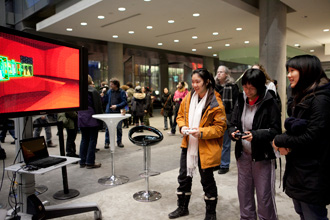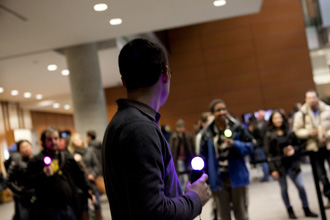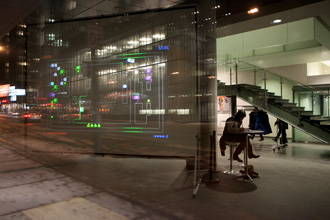President's Conference Series
This year’s edition of the President’s Conference Series at Concordia was a resounding success, says organizer Bart Simon, a professor in the Department of Sociology and Anthropology.
“The whole thing was a great team effort,” he says. “When all the different pieces of Concordia come together to pull off this scale of event, that’s the best thing.”

Simon admits that before the three-day event got underway, he didn’t know what to expect, which isn’t surprising as the conference was covering a rather niche cultural phenomenon: the Japanese media mix.
In the end, the public events were very well attended, and the audience knew its stuff. Simon says it proves that “Montreal is a happening centre for thinking about Japanese culture in general, but also more specifically the media mix.”
The conference kicked off Saturday night with a keynote lecture by famed Japanese manga artist and theorist Eiji Otsuka in the auditorium of the Grande Bibliothèque. Otsuka challenged popular notions surrounding the origins of manga.
The talk was sold out, which indicated to Simon that at least a certain segment of Montreal’s population knows its manga. “The people who understood what he was arguing against got a lot from that talk and were talking very highly about it,” he says.

Sunday’s symposium featured four separate panels, each containing presentations by two scholars. Marc Steinberg, an assistant professor at the Mel Hoppenheim School of Cinema who specializes in Japan’s media mix, assembled the list of speakers for the symposium.
“I think each paper spoke to the other and we got good dialogue going,” he says. “The audience seemed really interested in the subject, and we covered the media mix from a lot of different angles. I think it worked out really well.”
In his introduction to the day of talks, Simon recalled the discussions he had with Steinberg and history professor Matthew Penney when they were trying to decide what theme to focus on during the conference.
“We knew we wanted to think about something at the intersection of manga, anime and video games, and of course the concept of the media mix came up. But it’s the media mix as a kind of boundary object rather than a precise definition of the situation that sparked our interest and our conversation.”

Simon went on to insist that any further study of the media mix wherever it exists needs to focus on the experience of it, rather than its production, since its boundaries are unclear. “Not the media mix, perhaps, but the media mess,” he said. “With this I want to stress the messiness of our engagement with the mix […] our individual inability to consume everything in the mix.”
The presenters were encouraged to tackle different specific subjects that exist within the media mix. “We didn’t want to say vague things about the media. We wanted to actually talk about specific cases and then use them as ways to think about why this concept is important,” Simon adds.

Audience member Saturn De Los Angeles, an undergraduate history student at Concordia, attended the symposium because of his interest in Japanese popular culture. “I’m fascinated by the fact that there are people studying it from an academic perspective. It’s something I would never have known to exist,” he continued. “Each of the lecturers gave a very interesting take on it.
De Los Angeles says the subjects discussed at the symposium are symbolic of a paradigm shift happening in the media world. “Everyone can become creative, everyone can embrace this new technology and the fact is, it’s impacting everyone,” he says. “There’s this divide between people who want to stick to the old school ways of how things work and the new generation that is open to new things and embracing what’s coming ahead of us, and it’s really amazing to witness this.”

The closing public event for the President’s Conference Series, called Mixcade, was held in the lobby of the Engineering, Computer Science, and Visual Arts Integrated Complex on Sunday evening.
Mixcade, put on by members of Concordia’s research centre in Technoculture, Art and Games (TAG), Lab Six and a half, and the Mount Royal Game Society was designed to mimic an arcade. It showcased a selection of unique independent games made by local and international developers.
Speaking at the event, TAG coordinator Saleem Dabbous said he was surprised by how easily attendees figured out how to play the games, even the more complicated ones. “It’s been crazy how people are responding to them,” he said. Many were gravitating towards the Arcade Royale, an old video game cabinet retrofitted with a computer containing a selection of locally produced games
“It’s great because it’s all local talent featured on there,” Dabbous said. “And actually the creators are all here. I think they’re really enjoying all the feedback they’ve been getting about the arcade.”
Watch the video from the Mixcade event:
The President’s Conference Series event concluded with a day-long master class on Monday, attended by graduate students from across Canada and the United States. Be sure to read the master class blog by Valérie Cools.
Related links:
• Concordia’s research centre in Technoculture, Art and Games
• President’s Conference Series
• "Manga mania coming" – NOW, November 15, 2011
• "Experiencing the media mix" – NOW, January 10, 2012
• "A Japanese cultural icon speaks" – NOW, January 25, 2012
• "Changing the game at Mixcade" – NOW, February 1, 2012
• "Mingling with the media mix masters" – NOW, February 8, 2012
• "Modern manga's wartime roots" – NOW, February 8, 2012